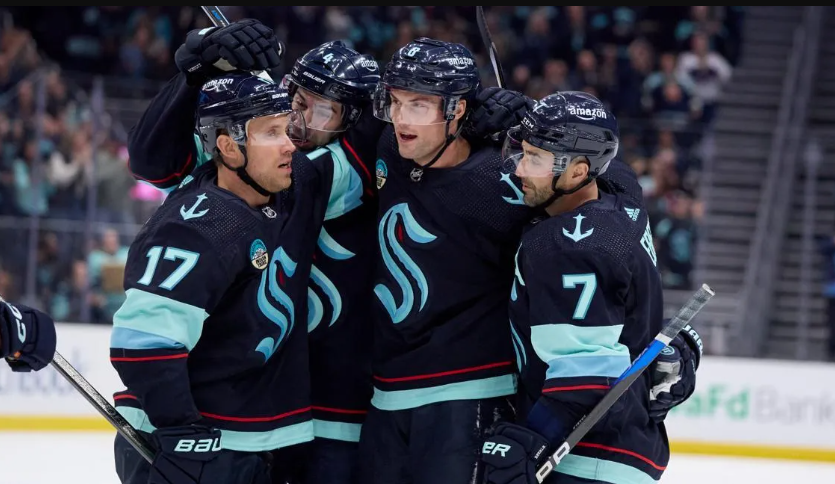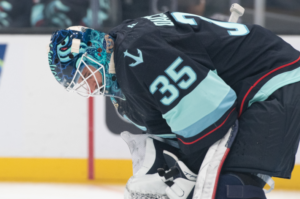
Seattle Kraken’s Struggles: Early Data Reveals Concerns for the Team

As the Seattle Kraken return home from a challenging five-game road trip and gear up for a six-game home stretch starting on Friday, now feels like an opportune moment to examine some early trends in the team’s performance data. This analysis will begin by exploring team-level statistics before delving into individual player performances. The goal here is to spark deeper reflection and further inquiry into the team’s play rather than to conduct a thorough deep dive into any one specific area. Given the nature of the data, each statistic could easily warrant its own article, so we will approach this as an overview. Unless otherwise specified, the data is sourced from Natural Stat Trick or NHL Edge.
Before diving into the numbers, it is important to note that the Kraken have played just 14 games out of their 82-game schedule. While this sample size represents about 17 percent of the season, it remains relatively small for drawing definitive conclusions. In fact, analytics platforms such as Evolving Hockey typically wait until a team has played 15 to 20 games before publishing their models, as this provides a more reliable sample. There is much to be learned from the early season data, but it is essential to keep a cautious perspective. With a new coaching staff in place, there’s a possibility that these trends could change significantly by the time we revisit this analysis later in the season, perhaps after the team has played around 30 games. With that in mind, let’s take a closer look at the current state of the Kraken.
Kraken’s Struggles in the Standings and Shot Quality Metrics
While it’s still early in the season, the first 14 games have had tangible implications for the Kraken’s playoff hopes. As of November 7, the team is only four points out of a playoff spot, but there are five teams between Seattle and the final wild card position, and some of those teams have games in hand. This makes the Kraken’s standing all the more precarious.
From a points percentage perspective, the Kraken are currently among the worst teams in the league. They rank fifth-worst in the NHL and third-worst in the Western Conference. This underperformance is not accidental, as the Kraken’s struggles in generating shot quality have been a major factor. Seattle ranks dead last in the league in expected goals for percentage (xGF%) at just 41.69 percent, meaning the team has been consistently outplayed in terms of creating quality scoring chances.
For those unfamiliar with expected goals (xG), it’s a metric that estimates the likelihood of a shot resulting in a goal based on factors such as shot location, type, and the situation in which the shot is taken. xGF% compares a team’s expected goals for (xGF) to its expected goals against (xGA), offering a sense of whether a team is generating more or fewer high-quality chances than it is giving up. For example, if a team takes shots worth 0.1 xG and allows shots worth 0.05 xG, its xGF% would be calculated as 0.1/(0.1 + 0.05) = 67 percent. With Seattle’s xGF% currently near the bottom of the league, it’s clear that the Kraken have been unable to generate enough high-quality offensive opportunities.
Seattle’s struggles are not limited to offense. The team’s defense has been just as problematic. Through 14 games, the Kraken are averaging only 2.79 goals scored per game, which ranks 21st in the league. At the same time, they are allowing 3.21 goals against per game, which also ranks 21st in the NHL. This lack of production on both ends of the ice has been a major contributing factor to their poor performance.
In terms of shot quality, Seattle has underperformed both in generating high-quality looks on offense and in suppressing the quality of shots from opponents. A closer look at the special teams units reveals some additional concerns. The Kraken have been slightly above average in drawing penalties but have struggled to convert those opportunities into goals. On the penalty kill, Seattle has been taking more penalties than the average team, which has led to them allowing more power-play goals than expected. These struggles on the special teams have compounded the team’s overall difficulties.
Seattle’s power play has also struggled to generate quality chances, and the team is one of the worst in the league at preventing high-danger shots while shorthanded. The Kraken’s goaltenders have been the primary reason the team hasn’t been even worse on the penalty kill, as they’ve done a solid job of stopping shots when they are facing high-danger opportunities.
Individual Player Data Reflects Teamwide Struggles
Turning our attention to individual player data, it’s clear that there are few bright spots on the roster, given the overall weaknesses in the team’s performance. However, there are interesting trends in how the coaching staff has deployed players and how those players have performed relative to each other.
Defensively, Brandon Montour has been a key player for the Kraken, logging significant minutes, especially with Vince Dunn sidelined for the last 10 games. Montour leads the team in ice time by a wide margin, showing how much the coaching staff relies on him. Up front, Chandler Stephenson stands out as the only forward seeing as much ice time as any of the top-four defensemen. Stephenson’s usage indicates that the coaching staff views him as a versatile player capable of contributing in all situations.
On the other hand, Shane Wright has had limited offensive involvement, which stands out when comparing his shot attempts to those of other players. The Kraken may want to consider reuniting Wright with better line combinations to help maximize his offensive potential. He was practicing with Oliver Bjorkstrand and Eeli Tolvanen, which could be a positive sign for his future performance.
Meanwhile, players like Josh Mahura and Tye Kartye have seen limited usage, especially on special teams. Both players have not been given significant roles on either the power play or penalty kill. Given that the Kraken’s penalty kill has been underperforming, there may be an opportunity to use Kartye’s aggressive style in a more prominent penalty-killing role.
In terms of zone starts, the data reveals some interesting insights into the coaching staff’s strategic choices. Adam Larsson has been deployed in the most difficult situations, often starting shifts in the defensive zone. In contrast, players like Mahura have been given more favorable offensive-zone starts. This deployment pattern provides some insight into how the coaching staff is managing players based on their strengths and weaknesses.
NHL Edge data also tracks players’ time spent in each zone, allowing us to evaluate whether they are maintaining or losing ice position. Only two Kraken players—Montour and Mahura—have spent more time in the offensive zone than the defensive zone. This is consistent with the coaching staff’s deployment strategy, but it also highlights the team’s overall struggles in driving play and controlling possession.
When it comes to goal-scoring and shot quality, two of the team’s top producers, Jordan Eberle and Jared McCann, are not merely benefiting from good luck. They also lead the Kraken in expected goals, indicating that they’ve been driving positive offensive play. Matty Beniers, the team’s third-leading scorer, also ranks highly in shot quality, which aligns with his three-goal total. However, some other players have been less effective in contributing to the team’s overall offensive output.
In terms of shot quality metrics, only one Kraken player—Shane Wright—has a positive expected goals for percentage (xGF%) above 50 percent. The rest of the team has struggled to generate good-quality chances at even strength. This reinforces the notion that Seattle’s offensive and defensive inefficiencies are widespread, affecting nearly all of their players.
Goalies: Contrasting Performances
Finally, the team’s goaltending performance has been uneven. Joey Daccord has made eight starts, posting a solid .915 save percentage and a 2.75 goals-against average. His shot-quality metrics show that he has saved nearly five goals more than expected, ranking him among the top goalies in the league in that regard. Daccord has excelled in handling low-danger shots, boasting the best save percentage in the NHL on such attempts. However, his high-danger save percentage has been slightly below average, with cross-seam passes proving to be an effective way for opponents to beat him.
Philipp Grubauer, on the other hand, has struggled more in the early season, with a .876 save percentage and a 3.27 goals-against average. His performance on high-danger shots has been better than Daccord’s, but he’s been below average on low-danger shots, which has led to him allowing more goals than expected. Despite these struggles, there may still be reasons for optimism, as his rebound control has been solid, and some of his early-season difficulties may be due to bad luck.
However, the early data paints a concerning picture for the Seattle Kraken. While it is still early in the season, the team’s struggles in generating shot quality, controlling possession, and performing on special teams have contributed to their disappointing start. The goaltending has been inconsistent, with Joey Daccord performing solidly but Philipp Grubauer facing difficulties. As the team moves forward, it will need to address these issues if it hopes to compete for a playoff spot. With a new coaching staff and plenty of time left in the season, however, there’s still room for improvement, and the Kraken will need to make adjustments to turn things around.

Leave a Reply